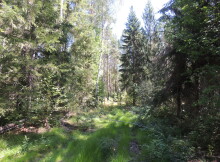SPATIAL PATTERNS OF VEGETATION DISTRIBUTION OF FOREST CATENAE AT DIFFERENT LEVELS OF THE PRISURSKY RESERVE
- Authors: Karakulova N.G.1
-
Affiliations:
- Arzamas Humanitarian and Pedagogical Institute named after A.P. Gaidar is a branch of the National Research Nizhny Novgorod State University named after N.I. Lobachevsky
- Issue: No 2 (2025)
- Pages: 1-9
- Section: Articles
- URL: https://bakhtiniada.ru/2500-0578/article/view/307456
- DOI: https://doi.org/10.21685/2500-0578-2025-2-5
- ID: 307456
Cite item
Full Text
Abstract
The vegetation of the Prisursky Nature Reserve has been insufficiently studied. The reserve's location at the border of nemoral and taiga community types, along with significant topographical heterogeneity, creates various combinations of these communities. The aim of this study is to identify the relationship between the patterns of forest vegetation distribution and the landscape structure. The research was conducted in the Alatyrsky section of the Prisursky State Nature Reserve (Chuvashia). A geobotanical profile measuring 5.5 km was established in the basin of the River Lyulya, extending from the watershed to the floodplain. Within this profile, the additional 9 shorter profiles were built. A total of 314 geobotanical descriptions were used for analysis, conducted according to the Braun-Blanquet methodology on plots of 100, 25 and 2.5 m². To characterise the phytocenoses, the ratio of the main ecological-cenotic groups of species was analysed. The ecological space of the ecotopes was assessed using the scoring ecological scales developed by D.N. Tsiganov. Plant community types for phytocenosis characterisation were identified according to the principles of dominant classification. Forest catenae of two levels were described: the first-order catena (in the basin of the River Lyulya) and second-order catenae (its tributaries). Six types of ecotopes were identified in the first-order catena, with background and additional communities described for each. A comparative analysis of the species composition and the ratio of ecological-cenotic groups of the plant cover in the two levels of catenae was conducted. The internal heterogeneity of plant communities, related to topographical irregularities, is an inherent characteristic that should be considered when describing the plant cover of areas with complex landscape structures. Moving from the upper to the lower parts of the first-order catena, there is an increasing participation of boreal species with a decreasing role of nemoral species; in the floodplain ecotope, the proportion of nemoral species rises again. The distribution of plant cover in catenae of different scales occurs in a similar manner.
About the authors
N. G. Karakulova
Arzamas Humanitarian and Pedagogical Institute named after A.P. Gaidar is a branch of the National ResearchNizhny Novgorod State University named after N.I. Lobachevsky
Author for correspondence.
Email: vertolotik@yandex.ru
Arzamas, Nizhny Novgorod Region, Russia
References
- Glazovskaya M.A. Landshaftno-geokhimicheskie osnovy fonovogo monitoringa prirodnoy sredy = Landscape-geochemical bases of background monitoring of the natural environment. Moscow, 1989:264. (In Russ.)
- Ipatov V.S. Reflection of vegetation dynamics in syntaxonomic units. Botanicheskiy zhurnal = Botanical jounral. 1990;75(10):1380–1388. (In Russ.)
- Zaugol'nova L.B. Characteristics of forest phytocatenas in the subzone of coniferous-broadleaf forests. Byulleten' moskovskogo obshchestva ispytateley prirody. Otdel biologicheskiy = Bulletin of Moscow Society of Naturalists. Biological series. 2001;106(5):42–50. (In Russ.)
- Sochava V.B. Vegetation classification as a hierarchy of dynamic systems. Geobotanicheskoe kartografirovanie = Geobotanical mapping. 1972:3–18. (In Russ.)
- Norin B.N. On the functional structure of plant groups in the forest-tundra. Botanicheskiy zhurnal = Botanical journal. 1970;55(2):170–183. (In Russ.)
- Zaugol'nova L.B. Main types of catenas and distribution of forest cover. Vostochnoevropeyskie lesa. Istoriya v golotsene i sovremennost' = Eastern European Forests: History in the Holocene and the Present. Moscow: Nauka, 2004;(bk.2):142–161. (In Russ.)
- Dedkov A.P., Distanov U.G., Latypov N.G. On the origin of the sands of the forest Zasurye. Trudy geologicheskogo instituta = Proceedings of the Geological Institute. 1971;(29):42–49. (In Russ.)
- Sultanova N.G. Distribution of forest vegetation in relation to landscape structure using the example of the Prisursky Nature Reserve: PhD dissertation. Pushchino, 2004:186. (In Russ.)
- Gusev M.V., Melekhova O.P., Romanova E. P. Sokhranenie i vosstanovlenie bioraznoobraziya = Conservation and restoration of biodiversity. Moscow: Izd-vo nauch. i uchebno-metodich. tsentra, 2002:286. (In Russ.)
- Nitsenko A.A. On the study of the ecological structure of vegetation. Botanicheskiy zhurnal = Botanical journal. 1969;54(7):1002–1014. (In Russ.)
- Zozulin G.M. Historical suites of vegetation of the European part of the USSR. Botanicheskiy zhurnal = Botanical journal. 1973;58(8):1081–1092. (In Russ.)
- Kurnaev S.F. Osnovnye tipy lesa sredney chasti Russkoy ravniny = The main types of forests in the central part of the Russian Plain. Moscow: Nauka, 1968:354. (In Russ.)
- Rysin L.P. Sosnovye lesa evropeyskoy chasti SSSR = Pine forests of the European part of the USSR. Moscow: Nauka, 1975:212. (In Russ.)
- Alekhin V.V. Complexes and construction of ecological series of association. Byulleten' moskovskogo obshchestva ispytateley prirody. Otdel biologicheskiy = Bulletin of Moscow Society of Naturalists. Biological series. 1923–1924; 32(1-2):99–112. (In Russ.)
- Kholod S.S. Classification of mountain slope phytocatenas. Botanicheskiy zhurnal = Botanical journal. 1991;76(9):1239–1249. (In Russ.)
- Tsyganov D.N. Fitoindikatsiya ekologicheskikh rezhimov v podzone khvoyno-shirokolistvennykh lesov = Phytoindication of ecological regimes in the subzone of coniferous-broadleaf forests. Moscow: Nauka, 1983:197. (In Russ.)
Supplementary files
























